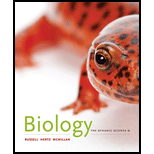
Concept explainers
What is the final acceptor for electrons in
a. oxygen
b. ATP
c. carbon dioxide
d. hydrogen
e. water
Introduction:
Cellular respiration consists of a series of reactions that are crucial for metabolism. The reactions that are involved in this type of respiration are catabolic in nature and involve the conversion of energy from organic nutrients.
Answer to Problem 1TYK
Correct answer:
Oxygen
Explanation of Solution
Explanation for the correct answer:
Option (a) is oxygen. Oxygen acts as the final acceptor of electrons in cellular respiration, which has a series of reactions. The electrons from organic molecules are transferred to oxygen. The process also involves several reactions that form ATP (adenosine triphosphate). This cellular respiration produces ATP at the end. Hence, option (a) is correct.
Explanation for the incorrect answer:
Option (b) is ATP. ATP in cellular respiration cannot act as a final acceptor of the electrons. ATP is produced from this reaction and cannot be the ultimate electron receptor. So, it is an incorrect option.
Option (c) is carbon dioxide. Carbon dioxide is the waste product during the process of cellular respiration. Later, it is used for the preparation of organic compounds, carbohydrates. So, it is an incorrect option.
Option (d) is hydrogen. Hydrogen ions are obtained from glucose during cellular respiration; they help in the formation of water when two hydrogen ions and one oxygen ion combine together. They are released at the end of the process. So, it is an incorrect option.
Option (e) is water. Energy is produced with the help of water during cellular respiration, along with carbon dioxide. The hydrogen and oxygen molecules combine to form water. It is a byproduct of the reaction. So, it is an incorrect option
Hence, options (b), (c), (d), and (e) are incorrect.
Therefore, it can be concluded that oxygen is the final acceptor in cellular respiration, since it becomes water in the cycle, by combining with the hydrogen atoms that are released, by the end of the process.
Want to see more full solutions like this?
Chapter 7 Solutions
Biology: The Dynamic Science (MindTap Course List)
- You intend to insert patched dominant negative DNA into the left half of the neural tube of a chick. 1) Which side of the neural tube would you put the positive electrode to ensure that the DNA ends up on the left side? 2) What would be the internal (within the embryo) control for this experiment? 3) How can you be sure that the electroporation method itself is not impacting the embryo? 4) What would you do to ensure that the electroporation is working? How can you tell?arrow_forwardDescribe a method to document the diffusion path and gradient of Sonic Hedgehog through the chicken embryo. If modifying the protein, what is one thing you have to consider in regards to maintaining the protein’s function?arrow_forwardThe following table is from Kumar et. al. Highly Selective Dopamine D3 Receptor (DR) Antagonists and Partial Agonists Based on Eticlopride and the D3R Crystal Structure: New Leads for Opioid Dependence Treatment. J. Med Chem 2016.arrow_forward
- The following figure is from Caterina et al. The capsaicin receptor: a heat activated ion channel in the pain pathway. Nature, 1997. Black boxes indicate capsaicin, white circles indicate resinferatoxin. You are a chef in a fancy new science-themed restaurant. You have a recipe that calls for 1 teaspoon of resinferatoxin, but you feel uncomfortable serving foods with "toxins" in them. How much capsaicin could you substitute instead?arrow_forwardWhat protein is necessary for packaging acetylcholine into synaptic vesicles?arrow_forward1. Match each vocabulary term to its best descriptor A. affinity B. efficacy C. inert D. mimic E. how drugs move through body F. how drugs bind Kd Bmax Agonist Antagonist Pharmacokinetics Pharmacodynamicsarrow_forward
- 50 mg dose of a drug is given orally to a patient. The bioavailability of the drug is 0.2. What is the volume of distribution of the drug if the plasma concentration is 1 mg/L? Be sure to provide units.arrow_forwardDetermine Kd and Bmax from the following Scatchard plot. Make sure to include units.arrow_forwardChoose a catecholamine neurotransmitter and describe/draw the components of the synapse important for its signaling including synthesis, packaging into vesicles, receptors, transporters/degradative enzymes. Describe 2 drugs that can act on this system.arrow_forward
- The following figure is from Caterina et al. The capsaicin receptor: a heat activated ion channel in the pain pathway. Nature, 1997. Black boxes indicate capsaicin, white circles indicate resinferatoxin. a) Which has a higher potency? b) Which is has a higher efficacy? c) What is the approximate Kd of capsaicin in uM? (you can round to the nearest power of 10)arrow_forwardWhat is the rate-limiting-step for serotonin synthesis?arrow_forwardWhat enzyme is necessary for synthesis of all of the monoamines?arrow_forward

 Concepts of BiologyBiologyISBN:9781938168116Author:Samantha Fowler, Rebecca Roush, James WisePublisher:OpenStax College
Concepts of BiologyBiologyISBN:9781938168116Author:Samantha Fowler, Rebecca Roush, James WisePublisher:OpenStax College Biology (MindTap Course List)BiologyISBN:9781337392938Author:Eldra Solomon, Charles Martin, Diana W. Martin, Linda R. BergPublisher:Cengage Learning
Biology (MindTap Course List)BiologyISBN:9781337392938Author:Eldra Solomon, Charles Martin, Diana W. Martin, Linda R. BergPublisher:Cengage Learning Comprehensive Medical Assisting: Administrative a...NursingISBN:9781305964792Author:Wilburta Q. Lindh, Carol D. Tamparo, Barbara M. Dahl, Julie Morris, Cindy CorreaPublisher:Cengage Learning
Comprehensive Medical Assisting: Administrative a...NursingISBN:9781305964792Author:Wilburta Q. Lindh, Carol D. Tamparo, Barbara M. Dahl, Julie Morris, Cindy CorreaPublisher:Cengage Learning Human Biology (MindTap Course List)BiologyISBN:9781305112100Author:Cecie Starr, Beverly McMillanPublisher:Cengage Learning
Human Biology (MindTap Course List)BiologyISBN:9781305112100Author:Cecie Starr, Beverly McMillanPublisher:Cengage Learning





